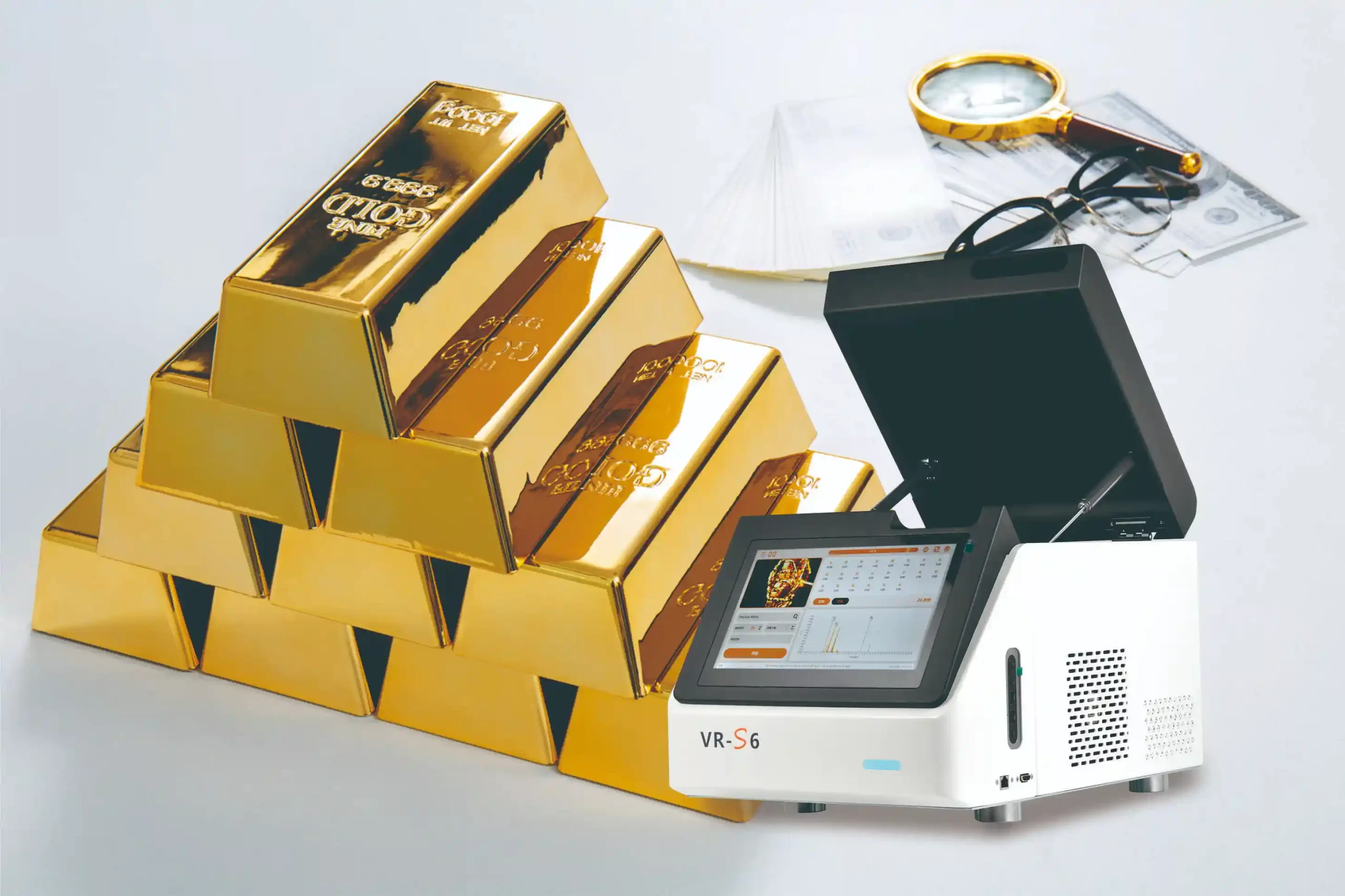How Do You Use an XRF to Test 21K Gold?
Using an XRF (X-ray fluorescence) analyzer to test 21K gold is fast, accurate, and non-destructive. You simply place the gold sample—whether it’s a ring, necklace, or raw material—onto the testing platform or under the sensor window of a handheld device. The XRF machine then emits low-level X-rays that excite the atoms in the sample. In seconds, the device reads the emitted energy and calculates the gold purity with high precision.

Gold Bars 1000 grams. Concept of wealth and reserve.
Unlike acid testing or fire assay, XRF requires no chemicals or sample preparation. It can be done in stores, labs, or even on-the-go with portable models. You simply power on the device, place the item in the test zone, and review the real-time results on the screen.
Why 21K Gold Testing Matters
21K gold is a common alloy containing approximately 87.5% pure gold and 12.5% other metals. It’s popular in markets across the Middle East and Asia due to its rich color and durability. However, verifying its exact purity is essential in resale, jewelry production, and gold recycling. Undetected impurities can reduce the item’s value or lead to fraudulent transactions. This is where XRF analyzers play a critical role.
With XRF testing, you don’t have to guess or rely on inconsistent chemical tests. Instead, you get immediate results backed by digital precision.
Step-by-Step: How to Test 21K Gold with an XRF Analyzer
1.Power On the XRF Device
Ensure the machine is calibrated (most modern devices like those from VRAY calibrate automatically or with one tap).
2.Place the Gold Sample on the Sensor Area
Whether you’re using a handheld device or a benchtop analyzer, gently place the gold item in the designated test spot. Ensure it’s clean and free of contaminants.
3.Initiate the Test
Tap the screen or press the button to begin analysis. The XRF beam will scan the sample, typically for 5–20 seconds depending on the device settings.
4.Review the Results
The screen displays the elemental composition—showing gold (Au) percentage, along with any other detected elements like copper or silver.
5.Save or Print the Report
For record-keeping, most devices allow you to store results, generate printable reports, or even send them digitally.
What Makes VRAY’s XRF Gold Testers Stand Out?
VRAY Instruments offers a full range of XRF gold testing analyzers that are engineered for speed, precision, and ease of use. Whether you’re testing 21K gold in a high-volume jewelry store or evaluating raw materials at a refinery, VRAY has a model to match your workflow.
🔹 Popular Models for 21K Gold Testing:
- [VR-X3] – A benchtop analyzer with gas proportional counter detector, ideal for jewelry shops.
- [VR-X5] – Features a Si-PIN detector and HD screen, capable of analyzing over 20 elements.
- [VR-M5] – Lightweight, portable, and perfect for mobile appraisals or remote gold purchasing.
- [VR-T9] – Built for ultra-high purity detection (±0.001%), perfect for industrial and wholesale gold assessment.
- [VR-H5] – A rugged, handheld device with dual-beam tech for quick spot-checking in pawnshops or recycling operations.
Each VRAY device is designed with user-friendly interfaces, real-time results, and robust safety features. They require no special training, and most models include pre-set gold purity modes—making 21K gold testing fast and foolproof.
Choosing the Right Model for Your Business
If you’re a retail jeweler, a compact benchtop device like the VR-X3 or VR-N3 provides a sleek, professional setup. For mobile testing or events, the VR-M5 or VR-H5 offers ultimate flexibility without compromising accuracy.
For high-volume wholesalers or precious metal labs, models like the VR-T7 or VR-T9 offer enhanced software features, customizable reports, and deeper analysis of complex alloys—critical when working with mixed or recycled materials.
Accuracy, efficiency, and client trust are at the heart of every VRAY instrument, giving your business a technical edge in a competitive market.
Practical Tips for Accurate 21K Gold Testing

- Clean the sample before testing—dust or residue can slightly affect readings.
- Avoid testing near other metals to prevent signal interference.
- Use the right collimator size for detailed or irregularly shaped pieces.
- Run periodic calibration checks (VRAY devices automate this).
- Keep firmware updated to ensure compatibility with evolving gold alloy profiles.
Why Businesses Trust XRF Over Traditional Methods
| Method | Accuracy | Destructiveness | Time Required | Portability |
| XRF Testing | ★★★★★ | None | <30 seconds | High |
| Acid Test | ★★☆☆☆ | Damaging | ~5 minutes | Moderate |
| Fire Assay | ★★★★★ | Destructive | Hours | Low |
Final Thoughts
Testing 21K gold accurately is essential for protecting your brand, ensuring fairness in transactions, and optimizing profit margins. An XRF analyzer gives you professional-level precision in seconds—with no waste, no mess, and no guesswork. Whether you’re buying, selling, recycling, or appraising, having the right XRF machine gives you confidence in every test.
With VRAY Instruments, you’re not just buying a machine—you’re investing in reliability, efficiency, and trust. Our gold testers are built to meet the evolving demands of modern precious metal analysis.
Frequently Asked Questions
- Can an XRF analyzer detect if 21K gold is fake?
Yes. XRF testing shows the exact elemental composition. If a sample contains less than ~87.5% gold or has unusual alloys, it’s likely not true 21K gold.
- Does the shape or size of the gold item affect the result?
Not significantly. However, very small or irregular items may require adjusting settings or using micro-focus features, available on VRAY models like the VR-T6 or VR-T7.
- Can I test other karats with the same machine?
Absolutely. All VRAY XRF analyzers can test 9K to 24K gold, silver, platinum, palladium, and more. Most models have preset modes for each karat level.
- Is XRF testing safe for daily use in a shop?
Yes. VRAY’s analyzers are shielded and certified to meet safety standards. Radiation exposure is minimal and contained within the device.
- How long does a typical gold test take?
Most VRAY devices deliver accurate results in 5–15 seconds, depending on the model and sample complexity.

WhatsApp
Scan the QR Code to start a WhatsApp chat with us.